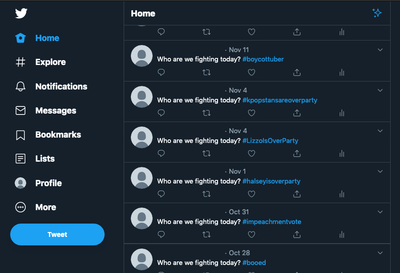User:Rita Graca/gradproject/prototyping/twittertrends: Difference between revisions
Rita Graca (talk | contribs) |
Rita Graca (talk | contribs) No edit summary |
||
| Line 84: | Line 84: | ||
</source> | </source> | ||
[[File:Bot timeline.png|thumb|Account timeline]] | [[File:Bot timeline.png|400px|thumb|left|Account timeline]] | ||
<br clear=all> | |||
===Get trends from historical archive=== | ===Get trends from historical archive=== | ||
Revision as of 22:39, 3 December 2019
Twitter trends
API
Cancel culture happens in Twitter through design features such as hashtags and trending topics.
To investigate better this movement, I understood I had to inform myself about which topics/people/things were being cancelled, how was the engagement with this topic, what were the language and strategies used.
1. Using the Twitter API I could get the current trends in the US.
Steps:
- Create a Twitter developer account
- Get keys and tokens from Twitter
- Install Ruby
- Install Twurl
- Install JQ to read JSON
- Use the command line
twurl "/1.1/trends/place.json?id=23424977" | jq
2. I was only interested in the trends related to cancel culture, so I used Python to develop the script a bit more.
Steps:
- Use Python library Tweepy
- Get trends
- Look for trends with words related with cancel culture
3. It was useful to save the trends. Instead of saving them in a .txt file, it made more sense to post them back in a Twitter account.
Steps:
- Create a status with the search results (a status is a tweet in the library)
4. To make it look for trends regularly I created a cron job on my computer.
46 * * * * /usr/local/bin/python3 /Users/0972516/desktop/ritaiscancelled/trends.py
Outcome:
The account @CancelledWho looks for trends related to my topic and posts them. This way I can be always monitoring an important topic of my research.
#!/usr/bin/python
import tweepy
import key # this is a pyhton file with my API passwords
import time
# using the passwords to OAuth process, authentication
auth = tweepy.OAuthHandler(key.consumer_key, key.consumer_secret)
auth.set_access_token(key.access_token, key.access_token_secret)
api = tweepy.API(auth)
trends1 = api.trends_place(23424977) # american woeid id
trends = set([trend['name'] for trend in trends1[0]['trends']]) # just getting the name, not timestamp, author, etc.
trendsLower = [item.lower() for item in trends] # makes everything lowercase, important for then to match with cancelwords.txt
trendsLine = '\n'.join(trendsLower) # makes it more readable, puts the names with line breaks
#print(trendsLine)
cancelwords = ["cancelled", "canceled", "cancel", "isoverparty", "booed", "boycott"]
#print(cancelwords)
for line in trendsLine.splitlines():
#print(line)
for word in cancelwords:
if word in line:
try:
status = "Who are we fighting today? " + line
print(status)
api.update_status(status) # Creates a tweet, a status is a tweet
time.sleep(5)
except tweepy.TweepError as e: # the error is occuring when the last status is the same
print("ups, you already tweeted this")
break
# time.sleep(3600) # so the script will wait 1h to run again if catches error
Get trends from historical archive
Use existing database
Scrape from existing website
(less accurate, abandoned)

